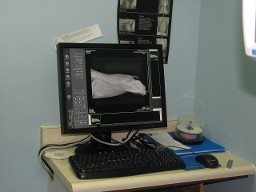Brandywine Hospital for Pets
1384 Brandywine BlvdZanesville, OH 43701(740)453-0539
brandywinehospitalforpets.com
|
Digital Radiography and Teleradiology
|
 Digital radiography refers to imaging modalities that obtain a digital radiographic image without using film. This technology offers several advantages over traditional film-based radiography, including improved imaging latitude, fewer retakes, access to teleradiology, and improved patient care through better image quality. Digital radiography refers to imaging modalities that obtain a digital radiographic image without using film. This technology offers several advantages over traditional film-based radiography, including improved imaging latitude, fewer retakes, access to teleradiology, and improved patient care through better image quality.
Fewer retakes mean fewer exposures, resulting in an overall decrease in radiation exposure to patients and personnel.
Teleradiology is the transmission of radiological patient images from one location to another via high-speed internet for the purpose of sharing studies with veterinary radiologists. This has decreased the time and distance barriers that previously hampered referring radiographs for a second opinion. In the past, mailing films to a radiologist meant a radiograph report turnaround of at least a few days. With teleradiology, report turnaround is measured in hours and even minutes.
Digital radiography came to Brandywine Hospital for Pets in December, 2008, and teleradiology quickly followed. Images are routinely sent for a consult in less time than it takes to burn the image to a CD.
|
Ultrasound
|
Ultrasound is the use of high-frequency sounds waves to generate an image of soft tissue such as the liver, intestines and kidneys. First used in human medicine in the early 1940s, veterinary medicine began to use the technology on small animals in the early 1980s.
This versatile technology is a noninvasive, safe means of obtaining important medical information. Ultrasonography can't be used to examine all body structures as any abrupt change in tissue density from soft tissues to bone or gas causes all the sound waves to be reflected back, producing and unreadable area on the monitor. Ultrasounds may give the veterinarian more information about a patient's condition but may not always be able to provide a final diagnosis.
In veterinary medicine, abdominal ultrasounds are the most common type performed. These can show any change in size, shape, texture or internal architecture of the abdominal organs. An abdominal scan can also safely determine a pregnancy much earlier than x-rays.
Patients generally are very comfortable during this procedure and usually do not require sedation.
Results are usually available very shortly after the brief procedure or within the same day.
|
|
|
